There's still strong demand for quality office and industrial space, experts say

Red-hot inflation and surging interest rates are headwinds for the commercial property market this year, but there’s still a strong demand for quality office and industrial space, according to experts.
Scott Campbell, Bayleys national director industrial and logistics, pointed to a lack of supply category-wide, and for sale and for lease, as the ongoing challenge facing the industrial sector.
Campbell said values have softened over the course of last year but have flattened out now, and were not expected to soften any further due to the cost of replacement, Stuff reported.
“Likewise, we’d expect vacancy rates to soften, too, as new developments catch up and come on stream,” he said.
Lloyd Budd, Bayleys executive director of Auckland commercial real estate, said demand for office property was also strong last year, as companies returned to the office that were now equipped with hybrid flexibility.
“As the market resets, and while occupiers try to accurately forecast their footprint requirements, sublease opportunities have appeared offering options to a broad range of businesses,” Budd said.
There was an ongoing flight to quality space, however, he noted, as businesses look for efficient floor plates, flexibility, and intuitive fitouts that reflected modern ways of working, and find secondary grade vacant buildings a challenge to work on.
“We expect ongoing interest from landlords and tenants for co-working or shared space to allow shrink and grow flexibility, and more focus on green builds,” Budd said.
The flight to quality was a trend both in the industrial and office sectors, as providing good space would help attract and retain staff.
“Twenty years ago, industrial properties were just big, dusty warehouses, but they are very different spaces these days,” said Gavin Read, JLL head of research. “They incorporate employee wellbeing, and some even have gyms. Occupants want to show quality workspace to potential clients, so they can see what the business stands for and how it operates.”
Some new industrial developments would become operational this year, particularly in Auckland and Christchurch, but many of those were already pre-leased and occupied, Read said.
“Demand for these large warehouse spaces is set to continue, despite the economic slowdown, and there will be a continuation of the 2022 rental growth story,” he said.
When it comes to office space, Read said the flight to quality meant there was a growing difference between prime and secondary property, and that was both a rental and a yield story.
“The risk of office vacancies is more in the secondary market,” he said. “In contrast, in Auckland’s CBD-Viaduct-Wynyard Quarter area, there is high demand and very low vacancies in newer buildings, for example.”
The flight to quality had been going on for a while now and would persist as office space continued to be improved, Read said.
“Occupants want to attract employees with a healthy environment, as well as good facilities and nearby amenities,” Read said. “But it is not just about wellbeing, it leads to greater productivity too.”
Read expected more commercial buildings would be refitted and repurposed this year, instead of getting knocked down and rebuilt.
“It’s due to the race to get to carbon zero, but it’s a massive global trend, and New Zealand will be part of it as we look at how we can improve in this area,” he said.
Scott McKenzie, PMG CEO, said investors would also find the flight to quality and a focus on sustainability initiatives important.
“Higher quality property attracts more resilient tenants who are better placed to weather economic storms,” McKenzie said. “So, given the environment we are moving into, the quality of the tenants and their business is important.”
This could present opportunities for long-term investors, as prices for good quality real estate adjusted to the new environment, making it possible for them to buy better, Stuff reported.
Use the comment section below to tell us how you feel about the outlook.



